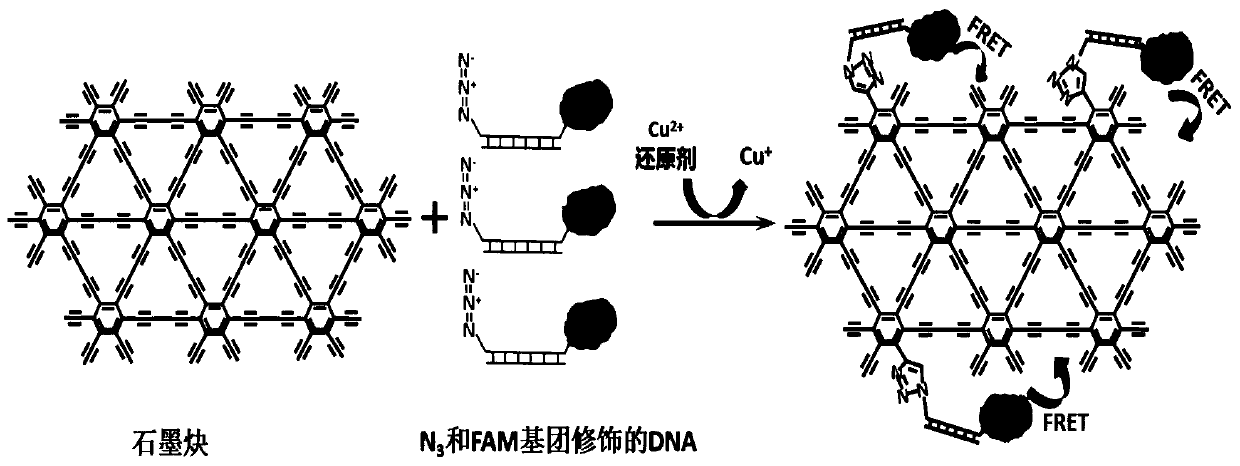Graphite alkyne and click chemistry-based copper ion detection method, kit and application
A detection method and click chemistry technology, applied in the field of detection, can solve the problems of reducing the repeatability of the reaction, increasing the complexity of the reaction, etc., and achieve the effects of low detection limit, high specificity, and simplified operation time and steps.
- Summary
- Abstract
- Description
- Claims
- Application Information
AI Technical Summary
Problems solved by technology
Method used
Image
Examples
Embodiment 1
[0058] The present embodiment provides a kind of detection method based on graphdiyne and the copper ion of click chemistry, comprises the steps:
[0059] (1) Add DNA1 with a concentration of 10 μM and a volume of 10 μL and DNA2 with a concentration of 10 μM and a volume of 10 μL into PBS buffer, mix at 95°C for 5 minutes to obtain group-modified double-stranded DNA, and store at 4°C;
[0060] (2) The group-modified double-stranded DNA obtained in step (1) and 2 μg graphyne were vortexed for 20 s in 0.2 mL of PBS buffer to obtain a mixed solution of graphyne and group-modified double-stranded DNA;
[0061] (3) adding a volume of 20 μL to the mixed solution of graphyne and group-modified double-stranded DNA obtained in step (2) is the copper ion standard solution of 100 nM, 500 nM, 1 μM, 5 μM, 10 μM, 100 μM and 1 mM respectively A volume of 20 μL of sodium ascorbate solution with a concentration of 5 mM was mixed to obtain a mixture (the concentration of graphyne in the mixture...
Embodiment 2
[0079] The present embodiment provides a kind of detection method based on graphdiyne and the copper ion of click chemistry, comprises the steps:
[0080] (1) Add DNA1 with a concentration of 5 μM and a volume of 10 μL and DNA2 with a concentration of 5 μM and a volume of 10 μL into PBS buffer, mix at 80°C for 8 minutes to obtain group-modified double-stranded DNA, and store at 4°C;
[0081] (2) The group-modified double-stranded DNA obtained in step (1) and 2.5 μg graphyne were vortexed and mixed for 30 seconds in 0.5 mL of PBS buffer to obtain a mixture of graphyne and group-modified double-stranded DNA ;
[0082] (3) Adding a volume of 50 μL to the mixed solution of graphyne and group-modified double-stranded DNA obtained in step (2) is the copper ion standard solution of 100 nM, 500 nM, 1 μM, 5 μM, 10 μM, 100 μM and 1 mM respectively and A volume of 50 μL of sodium ascorbate solution with a concentration of 1 mM was mixed to obtain a mixture (the concentration of graphyne...
Embodiment 3
[0092] The present embodiment provides a kind of detection method based on graphdiyne and the copper ion of click chemistry, comprises the steps:
[0093] (1) Add DNA1 with a concentration of 15 μM and a volume of 10 μL and DNA2 with a concentration of 15 μM and a volume of 10 μL into PBS buffer, mix at 100°C for 3 minutes to obtain group-modified double-stranded DNA, and store at 4°C;
[0094] (2) The group-modified double-stranded DNA obtained in step (1) and 7.5 μg graphyne were vortexed and mixed for 10 s in 0.5 mL of PBS buffer to obtain a mixture of graphyne and group-modified double-stranded DNA ;
[0095] (3) Adding a volume of 50 μL to the mixed solution of graphyne and group-modified double-stranded DNA obtained in step (2) is the copper ion standard solution of 100 nM, 500 nM, 1 μM, 5 μM, 10 μM, 100 μM and 1 mM respectively and A volume of 50 μL of sodium ascorbate solution with a concentration of 1 mM was mixed to obtain a mixture (the concentration of graphyne in...
PUM
| Property | Measurement | Unit |
|---|---|---|
| particle size | aaaaa | aaaaa |
| particle size | aaaaa | aaaaa |
| concentration | aaaaa | aaaaa |
Abstract
Description
Claims
Application Information
 Login to View More
Login to View More - R&D
- Intellectual Property
- Life Sciences
- Materials
- Tech Scout
- Unparalleled Data Quality
- Higher Quality Content
- 60% Fewer Hallucinations
Browse by: Latest US Patents, China's latest patents, Technical Efficacy Thesaurus, Application Domain, Technology Topic, Popular Technical Reports.
© 2025 PatSnap. All rights reserved.Legal|Privacy policy|Modern Slavery Act Transparency Statement|Sitemap|About US| Contact US: help@patsnap.com



